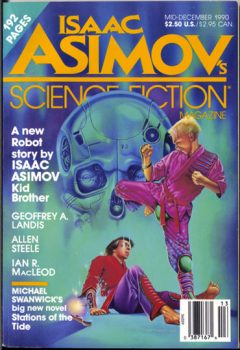A to Z Reviews: “3 RMS, Good View,” by Karen Haber
Real estate prices in San Francisco are notoriously high, which leads Karen Haber’s character in “3 RMS, Good View” to seek out extreme living arrangements. Despite her better judgement, she rents an apartment in near Haight and Asbury in San Francisco in 1968, despite working in the 2000s, for Chrissy lives in a world where time travel is inexpensive and easy.
Haber’s focus in not on the impact so many time travelers would have on the world, simply presenting a noninterference contract they all must sign. Instead, Haber focuses on the impact living in the past, and particularly that year and place, have on Chrissy and her cat, MacHeath. Haber does note that Chrissy can spend as much time in her 1968 apartment and never be late for work because she can set her arrival coordinates to whatever she needs them to be.

Eventually, despite trying to keep to herself to avoid breaking the noninterference contract, Chrissy meets her new neighbors, Duffy, Parvati, and their daughter, Rainbow, quickly defining themselves to be contemporaneous to the year in which they were living. Although Chrissy didn’t have much of a relationship with them, she did notice their daughter, especially after Duffy and Parvati moved out, but Rainbow was still, apparently, living in the apartment beneath hers with the new tenants.
One evening, Chrissy returned from real time to discover the apartment on fire. She grabs MacHeath and the time travel device and runs out of the apartment and heads back to her natural time, but not before seeing Rainbow’s body carried from the charred remains of the building. Seeing this senseless death that she couldn’t do anything about was enough to make Chrissy give up on living in the past and find an apartment in her own time.
Yet, Rainbow’s death continued to haunt her.
One of the problems with “3 RMS, Good View” is that because of the noninterference contract, Chrissy’s interactions with 1968 San Francisco are limited. She is only shown having a single conversation with Duffy, Parvati is completely off-stage, and while Rainbow appears throughout the story, she is barely more than a host, someone Chrissy glimpses through a window or across the yard. The distance and isolation undermines the connection that Chrissy later feels for Rainbow.
However, that isolation also contributes to one of the strengths of the story, as it means that even when Chrissy attempts to gain closure for her experiences in 1968 and with regard to Rainbow, she isn’t entirely successful. Her story, which should have ended with her cross-time lease, can’t be wrapped up within the confines of Haber’s tale, leaving a lasting impression of Chrissy and she moves on with her life.
 Steven H Silver is a twenty-time Hugo Award nominee and was the publisher of the Hugo-nominated fanzine Argentus as well as the editor and publisher of ISFiC Press for eight years. He has also edited books for DAW, NESFA Press, and ZNB. His most recent anthology is Alternate Peace and his novel After Hastings was published in 2020. Steven has chaired the first Midwest Construction, Windycon three times, and the SFWA Nebula Conference six times. He was programming chair for Chicon 2000 and Vice Chair of Chicon 7.
Steven H Silver is a twenty-time Hugo Award nominee and was the publisher of the Hugo-nominated fanzine Argentus as well as the editor and publisher of ISFiC Press for eight years. He has also edited books for DAW, NESFA Press, and ZNB. His most recent anthology is Alternate Peace and his novel After Hastings was published in 2020. Steven has chaired the first Midwest Construction, Windycon three times, and the SFWA Nebula Conference six times. He was programming chair for Chicon 2000 and Vice Chair of Chicon 7.

Thanks. I have not read much by Karen Haber, but I love this story.